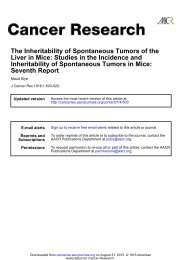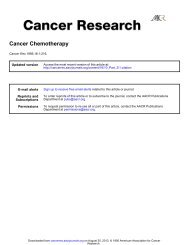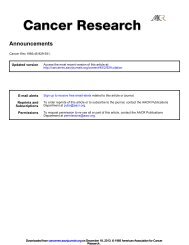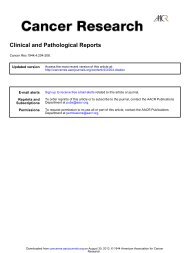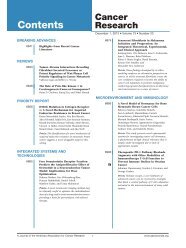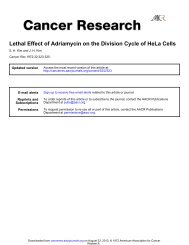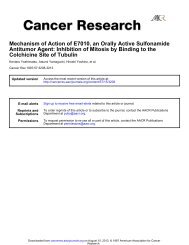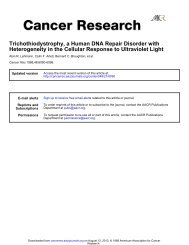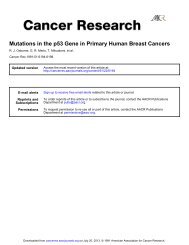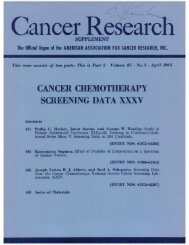Isolation and Characterization of a Hepatoma ... - Cancer Research
Isolation and Characterization of a Hepatoma ... - Cancer Research
Isolation and Characterization of a Hepatoma ... - Cancer Research
You also want an ePaper? Increase the reach of your titles
YUMPU automatically turns print PDFs into web optimized ePapers that Google loves.
NPT<br />
HAPT<br />
10 5 2.5 1.25<br />
CHARACTERIZATION OF A HEPATOMA ABNORMAL PROTHROMB1N<br />
1.25<br />
Fig. 3. Binding <strong>of</strong> 125I-concanavalin A to NPT <strong>and</strong> HAPT. Serial concentra<br />
tions <strong>of</strong> proteins were applied to nitrocellulose paper <strong>and</strong> incubated with radiolabeled<br />
concanavalin A. A, radiograph <strong>of</strong> the dot blot: B, densitometric scans <strong>of</strong><br />
HAPT (gray) <strong>and</strong> NPT (black).<br />
different assay methods, other investigators have also reported<br />
increased blood levels <strong>of</strong> APT in 63-74% <strong>of</strong> patients with<br />
hepatocellular carcinoma (11-13). We have named the APT<br />
found in the blood <strong>of</strong> these patients the hepatoma-associated<br />
abnormal prothrombin antigen.<br />
APT is found in the blood <strong>of</strong> patients with vitamin K defi<br />
ciency, patients with acquired disorders <strong>of</strong> hepatic function,<br />
<strong>and</strong> patients treated with coumarin anticoagulants (8, 9). In<br />
patients with vitamin K deficiency <strong>and</strong> patients taking cou<br />
marin, circulating APT rapidly disappears from the blood with<br />
parenteral vitamin K. In patients with hepatocellular carci<br />
noma, HAPT does not disappear with the administration <strong>of</strong><br />
parenteral vitamin K (10, 13). Therefore, these patients do not<br />
have vitamin K deficiency. In fact, measurements <strong>of</strong> blood<br />
vitamin K levels in two hepatoma patients found elevated levels<br />
<strong>of</strong> the vitamin.3 HAPT, furthermore, is eliminated or reduced<br />
with resection <strong>of</strong> the hepatoma (10, 13). Therefore, it could be<br />
concluded that HAPT is synthesized by the malignant hepatocyte<br />
<strong>and</strong> is characteristic <strong>of</strong> an acquired tumor defect in vitamin<br />
K-dependent carboxylation.<br />
HAPT has been detected in blood by immunochemical meth<br />
ods. However, antigenic identity between HAPT <strong>and</strong> APT<br />
found in the blood <strong>of</strong> patients taking vitamin K antagonists<br />
does not exclude the possibility <strong>of</strong> significant structural differ<br />
ences between these proteins. An example is Factor IX Cam<br />
bridge (23). Factor IX Cambridge has antigenic characteristics<br />
similar to those <strong>of</strong> abnormal (des-7-carboxy) Factor IX. How<br />
ever, Factor IX Cambridge has a point mutation at the -1<br />
residue <strong>of</strong> the propeptide resulting in a protein with an un-<br />
3 H. Liebman. unpublished observations.<br />
6496<br />
processed 18-residue amino-terminal propeptide. Therefore,<br />
the protein has a higher molecular weight than either native or<br />
abnormal Factor IX.<br />
In this report I have purified a HAPT from the ascites <strong>of</strong> a<br />
patient with hepatocellular carcinoma <strong>and</strong> have compared this<br />
protein to NPT <strong>and</strong> APT. Analysis <strong>of</strong> this protein shows<br />
structural identity to APT <strong>and</strong> further supports the hypothesis<br />
that HAPT results from a defect in the vitamin K-dependent<br />
posttranslational carboxylation <strong>of</strong> the prothrombin precursor<br />
by the malignant hepatocyte.<br />
Purified HAPT has the same molecular weight, amino acid<br />
analysis (exclusive <strong>of</strong> 7-carboxyglutamic acid content), <strong>and</strong><br />
amino-terminal structure as NPT <strong>and</strong> APT. Analysis <strong>of</strong> the 7carboxyglutamic<br />
acid content <strong>of</strong> HAPT shows the protein to<br />
be partially carboxylated with an average <strong>of</strong> 5 Gla residues/<br />
molecule. Electrophoretic analysis, in the presence <strong>of</strong> Ca(II),<br />
suggest that HAPT is more heterogeneous with regard to its<br />
Gla content than either NPT or APT. However, this apparent<br />
difference in Gla content between HAPT <strong>and</strong> APT is probably<br />
secondary to the methods used to isolate these proteins. The<br />
purification <strong>of</strong> APT (9) includes a barium citrate absorption<br />
step resulting in the removal <strong>of</strong> partially carboxylated pro<br />
thrombin species. The purification <strong>of</strong> HAPT does not include<br />
the barium absorption <strong>and</strong> utilizes an anti-prothrombin:Ca(II)<br />
column to remove contaminating native prothrombin. The immunoaffmity<br />
removal <strong>of</strong> NPT would leave partially carboxyl<br />
ated variants with less than 8 Gla residues in the HAPT<br />
preparation. Other investigators have prepared APT using dif<br />
ferent methods <strong>and</strong> this has resulted in an APT preparation<br />
which is more heterogeneous with regard to its Gla content (25,<br />
26).<br />
Hepatocellular carcinomas are associated with production <strong>of</strong><br />
aberrant <strong>and</strong> ectopie proteins including «-fetoprotein (27), ab<br />
normal vitamin B12 binders (24), erythroprotein (28), <strong>and</strong><br />
abnormal fibrinogens (29). The abnormal vitamin B12-binding<br />
proteins <strong>and</strong> fibrinogens are believed to result from aberrant or<br />
excessive glycosylation <strong>of</strong> these proteins. I studied the glycosylation<br />
<strong>of</strong> HAPT using a concanavalin A-binding assay to deter<br />
mine if this protein is also abnormally glycosylated. There were<br />
minor differences between HAPT <strong>and</strong> NPT in the binding <strong>of</strong><br />
1251-labeled concanavalin. These studies suggest that HAPT is<br />
/V-glycosylated to an equal or slightly lesser degree than NPT.<br />
Also previous studies on the role <strong>of</strong> sugar residues on the<br />
function <strong>of</strong> the vitamin K-dependent proteins find no evidence<br />
that glycosylation is essential for biologic activity.<br />
A rat model for the production <strong>of</strong> abnormal prothrombin by<br />
hepatocellular carcinoma was recently reported by Shah et al.<br />
(30). Their data are consistent with the "hypothesis that the<br />
tumors that increase circulating abnormal prothrombin are<br />
those that are capable <strong>of</strong> expressing the prothrombin gene, but<br />
that have lost the ability to express significant levels <strong>of</strong> the<br />
vitamin K-dependent carboxylase enzyme." The structural char<br />
acterization <strong>of</strong> the HAPT is consistent with this model since<br />
the only defect noted was a deficiency in 7-carboxyglutamic<br />
acid content.<br />
The expression <strong>of</strong> H APT by the malignant hepatocyte results<br />
from different biochemical derangements than those responsi<br />
ble for secretion <strong>of</strong> «-fetoprotein. APT is the product <strong>of</strong> a<br />
defective posttranslational processing step in the malignant<br />
hepatocyte. n-Fetoprotein production results from the reexpression<br />
<strong>of</strong> a suppressed fetal gene. The poor correlation between<br />
these two tumor markers supports the independence <strong>of</strong> these<br />
two acquired cellular defects (10-13). When measurements <strong>of</strong><br />
blood HAPT are used in combination with the assav for the<br />
Downloaded from<br />
cancerres.aacrjournals.org on July 30, 2013. © 1989 American Association for <strong>Cancer</strong> <strong>Research</strong>.




